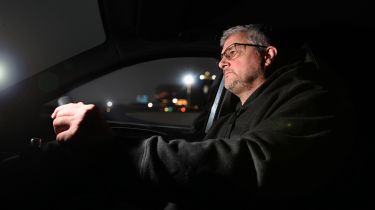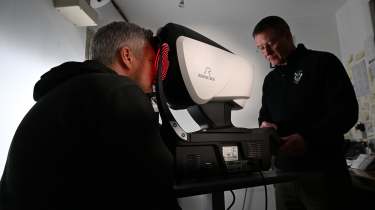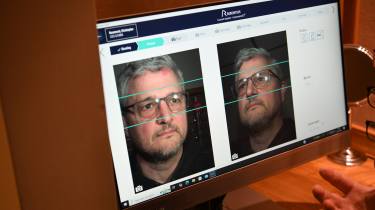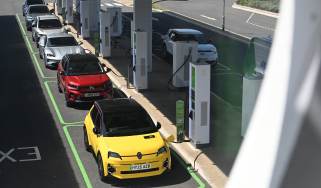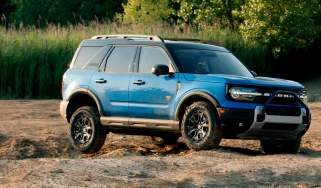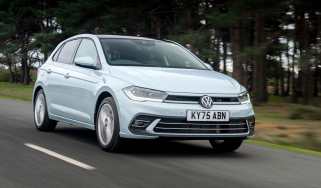Driver eyesight: is poor vision driving you to distraction at night?
As an ageing driver population faces vision challenges when driving in the dark, we take a look at cutting-edge tech designed to improve eyesight and keep people on the road
Age doesn’t come easily, and one of the first signs that you're getting on a bit is usually failing eyesight. Suddenly, driving at night becomes more of a guessing game as your eyes struggle to adapt to low-light conditions, interspersed with flashes of bright headlights.
Vision problems aren’t limited to the hours of darkness though, and with increasing numbers of older drivers on the road, it’s to be expected that more of us will face challenges. Typical age-related decline can make spotting hazards in the road, such as potholes, more difficult, as well as affect your ability to spot peripheral dangers or simply read road signs. In my case, reading dashboard dials has become almost impossible without bifocal lenses, and night-time driving is more of a strain than it used to be.
There’s also a long list of conditions among older people, including macular degeneration, cataracts, glaucoma and diabetic retinopathy, which can all have a significant effect on the ability to drive safely. Symptoms for these conditions can include a loss of peripheral sight, blurred vision, difficulty judging distances, disruptive light flashes or night blindness.
Fortunately, the challenge of worsening vision doesn’t necessarily mean the end of the road for drivers, but it definitely suggests the advice of an expert practitioner is in order. We visited Nicklins Opticians in Guildford, Surrey, where partner and dispensing optician Paul Davies demonstrated what’s accepted as one of the most cutting-edge technologies available on the high street for providing the best vision correction for drivers - the Rodenstock DNEye Scanner.
First, we got an insight from Paul about the capabilities of the DNEye Scanner, currently available at only a limited number of opticians, which is designed to create lenses that are far more ‘bespoke’ than your personal prescription. An important feature is that while a regular prescription is made in daylight conditions, the DNEye scanner combines readings for both day and night.
“It doesn’t just look at the lens, but actually how light passes through the eye,” says Paul. “Individuals all have aberrations, or slight imperfections in our vision, so we can measure those and build specific corrections into lenses that will reduce the effects.”
Sitting in front of the machine, the scan takes just a couple of minutes, and involves tracking a red dot as it moves around inside the viewfinder, accompanied by various flashes and visual effects. The DNEye Scanner records an incredible 7,000 measurements of so-called ‘high-order aberrations’, which are complex imperfections that affect the quality of the image projected by the cornea onto the retina, in both daylight and darkness.
The three important ones are known in the trade as ‘trefoil’, ‘coma’, and ‘spherical aberration’, which respectively can cause glare and halos around objects, seeing light points with a comet-like tail, and blurred vision. Together, especially at night, these factors can combine to significantly reduce visual acuity.
Paul shows me results that indicate low and medium levels of each, but higher levels of aberration at night.
He explains: “What happens at night is your pupil gets bigger to let in more light, and that’s often when people start struggling. That’s the argument behind these lenses, because it’s not glare that you’re dealing with, and if it’s uncorrected in your prescription it can lead to tired eyes. So, although it’s really beneficial for driving, it’s actually really good from an everyday point of view, too. That’s why we recommend it, and why people like it.”
By incorporating its scanner data (and those 7,000 individual measurements) into your regular prescription, Rodenstock claims its bespoke lens system offers “the sharpest vision of all time”, with improved contrast, especially at night, along with the largest fields of vision among the benefits.
But what's the price of returning your eyesight to as near perfect as is currently possible with a pair of spectacles? Today, it’s a potentially painful £500 or so, just for the lenses, but the good news is that a technology that’s currently rather exclusive should eventually trickle down into the mainstream. Meanwhile, what price would you put on having sharper vision, and more relaxing driving in the day and at night?
How vision problems can affect drivers
We asked Kevin Gutsell FBDO (Hons) SLD, president of the Association of British Dispensing Opticians and optical consultant, to provide Auto Express readers with his insights into how vision problems affect drivers – and more importantly, what you and your optician can do about it.
Many people tolerate less-than-optimal vision while driving, with the well reported problems of headlamp glare leading people to feel insecure when driving in dim light or the dark, potentially putting passengers, other drivers and pedestrians at risk.
Problems with vision can affect drivers in many other ways – typically motorists may suffer from distortion when using door mirrors, difficulty assessing distances or the inability to see instrument panels clearly. New technologies, including satellite-navigation or touchscreen displays positioned in the centre of the dashboard, augmented-reality guidance systems or digital rear-view mirrors can exacerbate these problems.
Driving is a complex task that requires specific visual skills: reacting to traffic signals, traffic lights, pedestrians, endless street signs and other vehicles. Peripheral vision is particularly important. Night myopia, a condition where the eye becomes nearsighted in low-light conditions due to changes in the eye's refractive properties, is an additional problem for some drivers.
The most advanced lenses and lens coatings can provide more confident and safe driving, particularly at night.
The RAC recently published a study into headlight glare, which found that 85 per cent of those affected feel the problem is getting worse. Of these drivers, 67 per cent are forced to slow down considerably until their vision clears, which can take six seconds or more. Yet, sadly, only six per cent of drivers experiencing difficulties had spoken to an optician about glare.
Opticians are experienced in dispensing the latest and most appropriate specs, which include tints and coatings specifically for drivers’ needs. For people struggling with night-time driving, bright sunlight and glare, there are multiple anti-reflection coatings, tinted and polarising lenses. These issues can affect drivers of any age.
Key vision issues for drivers, and what to do about them
Headlamp glare/dazzle
An almost mandatory question by the optician should be about personal driving habits: when, where and for how long. As stated before, the modern-day headlight is brighter and can be positioned higher on the front of the car.
A dirty windscreen and spectacle lenses needing a clean do not help, either. Anti-reflection coatings generally will make driving at night more comfortable, although those experiencing more discomfort or those who spend greater time driving after dark may well find specialist coatings even more beneficial.
Your dispensing optician, in conjunction with the optometrist, will be best placed to decide which product is most suitable for you. An anti-reflection coating is a must. You may also benefit from a lens design or a driving-specific coating to reduce glare and give wider distance vision.
Difficulties with night driving can be exacerbated by eye conditions such as cataracts. This again highlights the need for regular eye examinations, because there may come a point where your vision falls below the standards to drive. Wearing dark lenses is not the answer.
Inability to read the dashboard dials
Reading dashboard dials causes problems for drivers who are either not wearing up-to-date spectacles or contact lenses, or those with bifocals or varifocals/progressive lenses.
As a driver you should have your eyes tested at least every two years, and at that time your vision requirements can be discussed. For example, the modern dashboard is quite detailed, with many things to see. If you are struggling to see the smaller dials on the dashboard then you can be prescribed spectacle lenses to improve vision in these areas. Viewing the dashboard is more often an issue for those needing spectacles for distance, intermediate and near vision.
Over the past 30 years there has been a decline in people wearing bifocals. The more senior bifocal wearer may find virtually no area for middle distance in which the dashboard exists. The aesthetics of varifocals, increased use of laptops and computers (intermediate vision) and general improvements in spectacle lens technology have meant these issues have, to some degree, disappeared.
Top specialist lenses for drivers
Opticians carry a range of branded specialist products to help drivers. Here’s a rundown of some of the most popular and/or well respected brands:
EnRoute lenses
These lenses from Hoya focus on reducing glare and reflections caused by oncoming traffic and street lights. The lens is designed to give wide vision with improved contrast and brightness at night-time and at dusk.
Zeiss DriveSafe lenses
These lenses feature technology that’s designed to improve vision in low-light conditions. The firm’s DuraVision DriveSafe anti-reflection coating also targets night-time headlamp glare.
Rodenstock’s Solitaire Protect Road 2 coating
This is another premium anti-reflective coating, coupled with a light tint reducing glare at night and enhancing contrast during the day. It also has a specialist ‘clean’ coating, making it difficult for dirt to adhere to the lens. The company’s Road lens is designed to provide a large field of view over long distances for unrestricted vision.
Essilor Luxottica Crizal Drive Anti-reflection coating
The company claims a reduction of 90 per cent in reflections during night-time driving, compared with no lens coating. Crizal Drive offers resistance to scratching, easy clean, water-repelling properties and UV protection.
Did you know you can sell your car with Auto Express? Get the highest bid from our network of over 5,500 dealers and we'll do the rest. Click here to try Auto Express Sell My Car now...
Find a car with the experts

